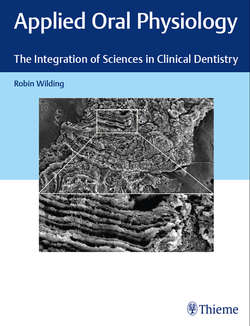Читать книгу Applied Oral Physiology - Robin Wilding - Страница 36
На сайте Литреса книга снята с продажи.
3.1.1 Oral Epithelium
ОглавлениеThe oral epithelium is a stratified layer of squamous cells which may either be keratinized or nonkeratinized. The characteristics of the individual layers (i.e., basal, prickle, granular, and keratin) are similar to those seen in the skin. Most of the cells of the epithelium are keratocytes. As they mature and are pushed to the surface by dividing cells in the basal layer, they will fill with keratohyalin granules and finally keratin.
There are three other types of cell in the epithelium.
• The melanocytes produce pigment and transfer it to the keratocytes around them. The number of melanocytes is no greater in heavily pigmented epithelium, but their activity is increased.
• The Langerhans and other dendritic cells are active in the immune response of the epithelium. They act as sentries, detecting the presence of foreign antigens on the surface of the oral epithelium. They then migrate from the epithelium to local lymph nodes where they present information about surface antigens to T (CD4) lymphocytes. The Langerhans cells do not have desmosome attachments, and so during histological processing the cytoplasm shrinks down around the nucleus producing a clear halo. Hence, these cells are referred to as clear cells.
• The Merkel cell is a mechanical receptor for tactile sensations.
The superficial layers of the epithelium may be both keratinized and nucleated. Keratinized epithelium is almost impermeable, due to a glycoprotein intercellular cementing substance, special cell junctions (desmosomes), and the keratin within the cell. Keratin (Greek, kera = horn) is a fibrous protein which is the main constituent in hair, hide, horns and hooves, claws, scales, feathers, and beaks. It is made up of a triple helix in a left-handed coil (contrary to the right-hand coil of collagen). The keratin fibers form a meshwork around the nucleus of the cell and attach to the desmosome plates inside the cell wall. Unlike collagen fibers, they remain within the cell (intracellular), where they provide a scaffolding joining one cell junction to another. The components for synthesizing the keratin molecules come from the constituents of the cytoplasm of the cell itself. As the content of keratin increases, the cell shrinks, shrivels up, dries out, and becomes lifeless but very tough.
The surface ultrastructure is characterized by microinvaginations on the surface side of the flattened squamous cell and microprojections on the deep side (▶ Fig. 3.1). The projections of the cell above interlock like a press stud with the invaginations on the surface of the cell below, providing a strong bond between the cells. Nonkeratinized epithelium is in general thicker than keratinized epithelium. It is slightly more permeable, but only to low-molecular-weight compounds such as glyceryl trinitrate (used to relieve an attack of angina pectoris). The surface ultrastructure lacks a robust interlocking mechanism with the adjacent cells which are readily detached from each other by light mechanical scraping.
